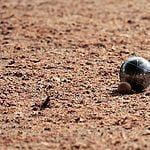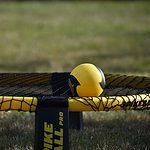When it comes to selecting a pickleball paddle, you may be thinking that all paddles are essentially the same. However, choosing the right paddle can significantly impact your game. Factors like paddle shape, core material, face material, handle length, weight, and grip comfort all influence your playing experience.
Understanding how these elements affect your performance is crucial. So, how do you navigate through these considerations to find the perfect pickleball paddle for you? Let's explore some key aspects that will guide you in making an informed decision.
Key Takeaways
- Paddle shapes and grip lengths impact play style and comfort.
- Core and face materials influence power, control, and shot precision.
- Handle length and weight affect maneuverability and power delivery.
- Proper grip size enhances wrist range, shot handling, and overall performance.
Pickleball Paddle Shapes
When selecting a pickleball paddle, the shape plays a crucial role in determining your playing style and performance on the court. Paddle shapes vary to cater to different needs.
Elongated paddles are designed to provide players with increased reach and power potential. These paddles allow you to cover more ground on the court and hit the ball with greater force, making them suitable for players looking to dominate the game with aggressive shots.
On the other hand, wide-body paddles are recommended for beginners as they offer a larger ball contact area. This feature provides better control and helps new players find their sweet spot more easily, enhancing their overall gameplay experience.
Grip lengths also contribute to the paddle shape dynamics, accommodating various hand sizes and preferences. Ultimately, the shape of your pickleball paddle can significantly impact your play style by influencing factors such as reach, power, and the positioning of the sweet spot for optimal performance.
Paddle Core Materials
Different paddle core materials offer distinct advantages and characteristics that directly impact your playing experience on the pickleball court. When selecting a paddle core material, it's essential to consider factors such as play style, durability, power, and touch to enhance your performance. Here is a comparison table of common paddle core materials:
| Core Material | Characteristics | Ideal for |
|---|---|---|
| Graphite | Lightweight, responsive | Players seeking power |
| Carbon Fiber | Stiff, powerful | Aggressive players |
| Polymer | Lightweight, durable | Touch and quiet play |
Each core material influences the paddle's feel and performance differently, catering to various player preferences. Graphite paddles offer power, carbon fiber provides stiffness for strong shots, while polymer paddles excel in touch and durability. Choose a core material that aligns with your play style to optimize your gameplay experience on the pickleball court.
Paddle Face Materials
To enhance your pickleball playing experience further, understanding the impact of paddle face materials is crucial as they influence power, control, and shot precision on the court. When choosing a pickleball paddle, consider the following:
- Fiberglass Face Material: Offers a blend of power and flexibility, ideal for intermediate players seeking a balance of power and control.
- Carbon Fiber Face Material: Provides significant power control, a larger sweet spot, and precise shot capability, making it suitable for players looking for enhanced performance.
- Composite Core: Made of materials like fiberglass, offering a blend of power and flexibility for players seeking a versatile option on the court.
- Impact on Gameplay: The face material influences energy absorption, ball response, and spin generation, impacting your overall performance during play.
- Hybrid Face Materials: Combine different elements to enhance specific playing characteristics like power, spin, or touch, catering to individual player preferences and styles.
Paddle Handle Lengths
Have you ever considered how the length of a pickleball paddle handle can impact your gameplay experience?
Pickleball paddle handle lengths typically range from 4 ½ to 5 ¼ inches, influencing grip comfort and play style. Shorter handles provide more control and maneuverability during gameplay, allowing for quick reaction times and precise shots. On the other hand, longer handles offer increased reach and power, making them ideal for players needing extra reach on shots and more power behind their hits.
When choosing a handle length, it's crucial to consider your personal preference and playing needs. Opting for a comfortable grip size is essential for optimal performance on the court, ensuring that you can play comfortably for extended periods without sacrificing control or power.
Ultimately, the choice of handle length comes down to your individual play style and what feels best in your hands to maximize your gameplay experience.
Paddle Weight Considerations
When considering pickleball paddle weight, it's crucial to understand how it directly impacts your playing style and performance on the court. The weight of a paddle can significantly influence your game, affecting factors such as maneuverability, power, stability, and control.
Here are some key points to consider when choosing the right paddle weight for you:
- Lightweight: Prioritizes maneuverability and speed on the court.
- Middleweight: Offers a balanced combination of power, stability, and control.
- Heavyweight: Designed for significant power, stability, and plow through shots.
- Individual Playing Style: Choose a weight that complements your style of play.
- Comfort Preferences: Consider the weight that feels most comfortable and natural in your hand.
Grip Size Selection
Consider the various pickleball grip sizes available, such as Thin Grip, Standard Grip, and Thick Grip, to optimize your gameplay performance. Choosing the right paddle grip size is crucial for enhancing spin, shot handling, and overall pickleball gameplay.
Smaller grip sizes offer players increased wrist range of motion, which can lead to more powerful shots and improved spin control on the ball. To identify the ideal grip size for you, place your pointer finger between your fingertips and the palm while gripping the paddle; this ensures a comfortable fit that promotes optimal performance.
If you find yourself in between sizes, opting for a smaller grip size can boost your control and maneuverability on the court. Remember, the proper grip size plays a significant role in your ability to handle shots effectively and maneuver the paddle with ease, so take the time to choose the right fit for your game.
Identifying Your Player Type
To determine your player type in pickleball, assess whether you excel in power shots, precise control, or a combination of both. Understanding your player type is crucial for selecting the right paddle that complements your strengths and enhances your game.
Here are some key points to consider:
- Power Player: Focuses on generating strong shots, requiring paddles with technology that enhances power.
- Control Player: Prioritizes accuracy and touch, needing paddles that provide precision and finesse.
- All-Court Player: Seeks a balance of power and control, requiring versatile paddles that cater to various playing styles.
Identifying whether you lean towards power, control, or a mix of both can help narrow down paddle choices.
The right paddle can significantly enhance your game by aligning with your playing style and strengths.
Determining Hand Size
To accurately determine the appropriate grip size for your pickleball paddle, measure your hand size by placing a ruler from the base of your palm to the tip of your ring finger. Hand size plays a crucial role in grip selection, impacting comfort and control during gameplay. Smaller hands may find thinner grips more suitable as they provide better maneuverability and shot accuracy. On the other hand, individuals with larger hands might benefit from thicker grips to reduce wrist strain and enhance stability while playing. Selecting the proper grip size ensures a secure and comfortable hold, ultimately leading to improved performance on the court.
| Hand Size | Grip Recommendation |
|---|---|
| Smaller | Thinner grips for enhanced maneuverability and shot accuracy |
| Larger | Thicker grips to reduce wrist strain and increase stability |
| Proper Grip Size | Ensures a secure and comfortable hold for improved performance |
| Impact on Play | Comfortable grip enhances control and overall playing experience |
Key Questions for Paddle Selection
When selecting a pickleball paddle, it's crucial to evaluate key factors that align with your playing style and preferences. Here are some key questions to consider for paddle selection:
- Grip Size: Determine the grip size that feels most comfortable and secure in your hand.
- Core Material: Evaluate different core materials like polymer, aluminum, or nomex for their impact on power and control.
- Surface Material: Consider the surface material such as graphite, fiberglass, or composite for its texture and durability.
- Weight: Decide on the weight of the paddle that suits your strength and playing style, whether you prefer a lightweight or heavier option.
- Customization Options: Look for paddles that offer customization options like color choices, grip wraps, or personalization to match your preferences.
Paddle Fitting Guide
What factors should you consider when determining the correct grip size for your pickleball paddle?
Grip size plays a crucial role in your performance on the court. When selecting a grip size, consider the size of your hand and how it affects your control and power during play. Grip sizes range from thin to thick, catering to different hand sizes and preferences.
To find the right grip size, place your pointer finger between your fingertips and palm. This positioning ensures optimal comfort and control while playing. Smaller grip sizes can provide increased wrist range of motion, allowing for enhanced spin and power in your shots.
If you find yourself in between sizes, opting for a smaller grip can improve your control and maneuverability on the court. Remember, grip size is a vital component of paddle fitting, directly impacting your performance and comfort during pickleball matches.





